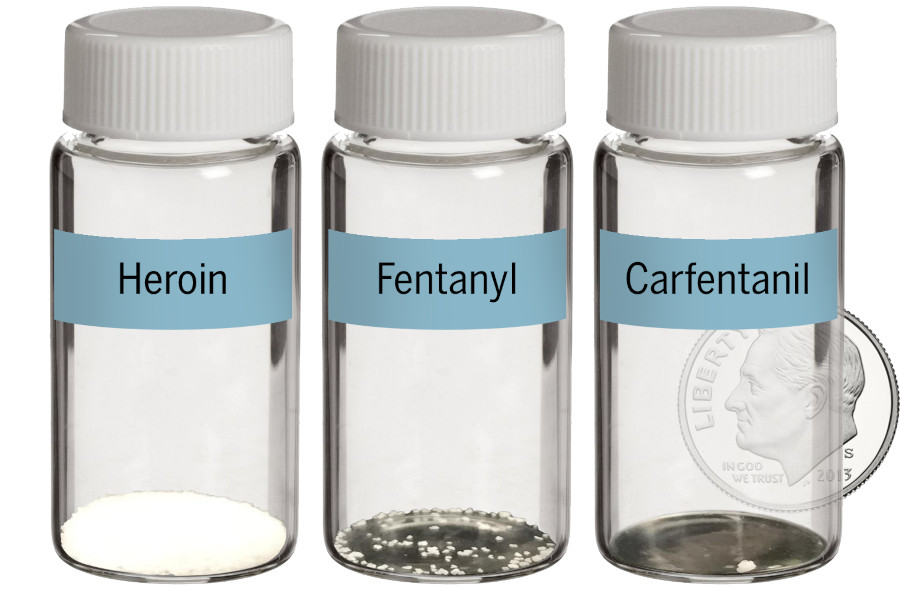Fentanyl is a synthetic opioid, found to be 50-100 times stronger than morphine, which makes it a very effective opioid and therefore, very dangerous. Fentanyl was developed as a pain killer, directed to help manage pain during treatment. Is commonly prescribed as a slow-release patch for cancer patients.
Opioids in general are easily misused, and fentanyl is no exception; however, being the potent that it is, fentanyl has managed to have a main role in the opioid epidemic. According to the CDC, fentanyl was present in 70% of overdose deaths in 2020.
Lethal Opioid Doses
| Opioid | Relative Potency | Lethal Dose Size |
|---|---|---|
| Morphine | 1x | 1 Pea |
| Heroin | 2x | 1 Sunflower Seed |
| Fentanyl | 100x | 1 Sesame Seed |
| Sufentanil | 500x | 1 Grain of Sand |
| Carfentanil | 10,000x | 0.5 Grains of Salt |
Sufentanil and carfentanil are fentanyl analogs, which means they a substantially similar in chemical structure.
Comparison of lethal doses

Photo: bostonglobe.com
Fentanyl and the Opioid Crisis
The opioid crisis in the United States is a complex and devastating public health emergency characterized by the widespread misuse and abuse of opioids, including prescription painkillers, heroin, and synthetic opioids like fentanyl.
Opioid Pain Medication Overprescription
The opioid crisis in the U.S. was initially driven by the overprescription of opioid pain medications.
Healthcare providers were incentivized to prescribe these medications due to pharmaceutical marketing practices that emphasized their effectiveness and downplayed the risks of addiction.
The Misleading Marketing of OxyContin
OxyContin (brand name of oxycodone) was introduced to the market with aggressive marketing campaigns that claimed it was less likely to be addictive due to its slow-release formulation. Unfortunately, these claims were false, and OxyContin proved to be highly addictive.
Users often crushed the pills to bypass the time-release mechanism, leading to rapid and intense euphoria.
Physicians were encouraged to prescribe it for a wide range of pain conditions. Many patients who initially received OxyContin for pain management purposes became addicted to them. As their prescriptions ended, they faced a dilemma—seek alternative sources of opioids or confront the painful and distressing symptoms of withdrawal.
This is where fentanyl comes in. Fentanyl often mixed with other drugs or sold as counterfeit pills, became readily available in the underground drug market.
Fentanyl’s potency is a major factor in the alarming rise of opioid-related overdoses and deaths. Users who had become accustomed to less potent opioids like OxyContin were ill-prepared for the strength of fentanyl.
Even minuscule amounts of fentanyl can lead to overdose and death. This hidden danger has turned fentanyl into a leading cause of opioid-related fatalities. It’s estimated that a dose of just 2 mg (approx. equivalent to a few grains of salt) can be fatal to most individuals who have not developed a significant tolerance to opioids.
How do you feel after taking fentanyl?
Opioids are meant to reduce pain, physically and even emotionally. For people with chronic pain, recuperating from surgery or enduring treatment, opioids are an aid that allows them to function on a daily base. However, when misused they have different effects:
- Euphoria
- Drowsiness
- Relaxation
- Difficulty concentrating
- Constricted pupils
- Slowed breathing
- Nausea
- Vomiting
- Constipation
- Loss of appetite
- Sweating
Fentanyl Mixed in Other Drugs
Fentanyl is a very potent opioid, making it an “ideal” and cheap option for some drug dealers. Fentanyl has been found mixed with drugs such as heroin, cocaine, methamphetamine and MDMA.
Consuming fentanyl drug mixtures is very dangerous and extremely risky. Imagine a someone who uses drug X, and is used to a specific dosage. If the substance in use is laced with fentanyl, the dose becomes completely unreliable and may lead to an accidental overdose.
Fentanyl Toxicity
Fentanyl predominately acts at the µ-opiate receptor. As such, fentanyl produces similar effects to other opiates, like morphine and heroin. It’s also highly addictive and with repeated use, it can lead to a quick development of tolerance.
The estimated lethal dose of fentanyl in humans is 2 mg. Blood concentrations of approximately 7 ng/ml or greater have been associated with fatalities where more than one substance use was involved.
Spotting a Fentanyl Overdose
Fentanyl overdoses can be reversed with the use of naloxone (a fast-acting drug used to temporarily reverse the effects of opioid overdoses), but first, you need to know how to identify one.
Fentanyl is an analgesic, so by default, its effect is to make a person “relaxed/numb/sleepy”.
A person who’s overdosing on fentanyl will first become sleepy and will be hard to wake up. Their breathing will slow down, they might make gurgling sounds and pass out. If you try to move them, their body may be limp. Their face will start to become pale, clammy and/or sweaty. Their pupils might be constricted, small. If the person is light-skinned, check their lips and fingertips; they may turn blue/purple. For a person who is darker-skinned, check the inside of their lips; they may turn blue/purple.
Step 1: Call 911, or the emergency number of your corresponding country, right away. Never leave someone who you suspect is overdosing alone.
Note that Canada and the US have adopted The Good Samaritan Drug Overdose Act. Which protects you from being charged or convicted for drug possession if you call 911 to report an overdose, or if you are at the scene when emergency services arrive. This is true even if you are on probation for possession.
Step 2: Check if the person has any remaining pills in the mouth or any slow-release patches on his/her skin. If they do, remove them. Otherwise, the person will keep absorbing fentanyl!
If you have naloxone, give it immediately! It will temporarily reverse the effects of an overdose.
Naloxone can treat a fentanyl overdose when given right away. It works by rapidly binding to opioid receptors and blocking the effects of opioid drugs. But fentanyl is stronger than other opioid drugs like morphine and might require multiple doses of naloxone.
Step 3: As you wait for help to arrive, try to wake the person up and pay attention to their breathing.
Lay the person on their side to avoid choking.
If the person stopped breathing administer a second dose of naloxone if you have it. Otherwise, perform CPR and chest compressions.
Note that naloxone can produce uncomfortable withdrawal symptoms. If the person wakes up, explain gently what’s happening.
Fentanyl Test Kits for Harm Reduction
Reducing the risk of consuming a fatal dose of fentanyl is possible. Testing for the presence of fentanyl and fentanyl analogues such as carfentanil requires the use of test strips, as offered here:


